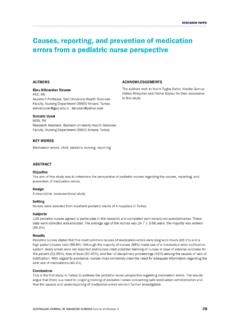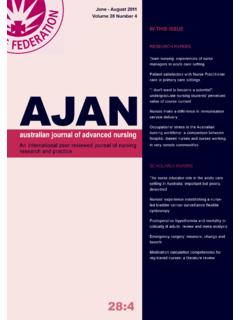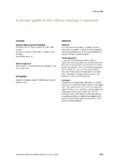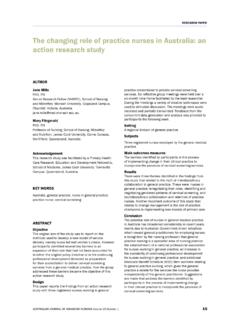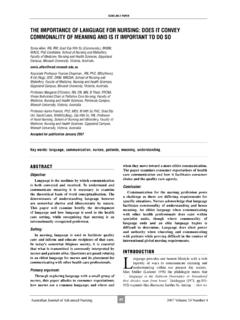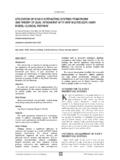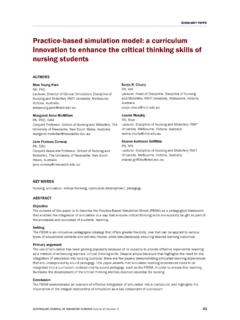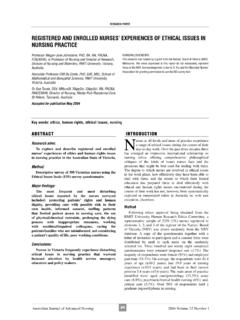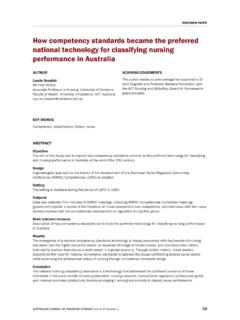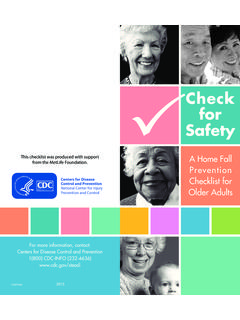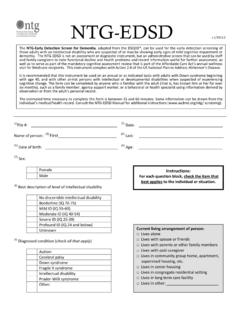Transcription of PHYSICAL RESTRAINT USE ON PEOPLE WITH DEMENTIA: …
1 SCHOLARLY PAPER. PHYSICAL RESTRAINT USE ON PEOPLE with dementia : A REVIEW OF THE LITERATURE. Wei-Wei Wang, RN, BN, MGeroNurs, Regis Group PTY Ltd, Brisbane, Queensland, Australia Professor Wendy Moyle, RN, PhD, MHS,c BN, DipAp Sci, Deputy Director of Research Centre for Clinical Practice Innovation, Griffith University, Nathan, Australia Accepted for publication October 2004. Key words: PHYSICAL RESTRAINT , dementia , long term care, aged care ABSTRACT: INTRODUCTION. PHYSICAL RESTRAINT is defined as any device attached or Objective: adjacent to the patient's body, which the patient is unable To provide a critical review of contemporary to remove easily and that restricts freedom of movement literature published between 1992 and 2003 on the use as well as access to one's body (Miles and Meyers 1994).
2 PHYSICAL RESTRAINT use has had a long history in the of PHYSICAL restraints on residents with dementia in management of aggressive patients and, in particular, the long-term care. institutionalised mentally ill (Burton et al 1992b; Evans and Strumpf 1989). Although the RESTRAINT of the mentally Design: ill was declared unnecessary, and never justifiable in the Forty-two manuscripts related to dementia early part of the nineteenth century (Psychiatric Services (cognitive impairment) and PHYSICAL RESTRAINT in long- 2002, ), it was not until psychotropic medications were introduced in the 1960s that the practice dropped term care settings were examined.
3 Dramatically in psychiatric institutions (Burton et al 1992b). However, the use of restraints has remained Results: popular for frail older PEOPLE , and a range of PHYSICAL Four dominant themes were identified in the restraints have been used, at least since the 1900s, in long- literature: relationship between RESTRAINT use and term aged care (Castle and Mor 1998). The justification for this practice rests mainly in prevention', for example cognitive decline; falls/related injuries and associated of falls, patient interference with treatments, injury to self mortality; reduction/removal/alternatives to use; and, and others, and aggressive behaviour and wandering.
4 Nurses' attitudes to restraints . It appears that despite In the 1960s the use of RESTRAINT was challenged as nurses' desire to use PHYSICAL RESTRAINT for protection it was suggested that RESTRAINT use intensified the there is no scientific evidence that PHYSICAL RESTRAINT disorganized behaviour of patients (Castle and Mor 1998;. actually protects residents against injuries. A Evans and Strumpf 1989). In 1979 the use of RESTRAINT on patients with a diagnosis of dementia was not discussion of the methodological issues arising in the recommended (Evans and Strumpf 1989).
5 Throughout the literature and recommendations for further research 1980s RESTRAINT use was influenced by a number of and implications for nursing practice are outlined. external factors that focused on the potential negative consequences and the unethical nature of the practice. For Conclusion: example, a number of European countries issued a To curb the practice of RESTRAINT use the challenge to the practice of RESTRAINT as they commenced RESTRAINT -free care. In North America, legislation declared concentrated assistance of Australia federal and state the right of residents to be free from RESTRAINT imposed governments and peak geriatric and dementia as a disciplinary measure, or for convenience purposes.
6 Organisations may be required. At the same time there was a general advocacy movement towards patient autonomy and a RESTRAINT -free environment, proposing alternative methods, and spearheaded by consumer groups such as National Australian Journal of Advanced Nursing 46 2005 Volume 22 Number 4. SCHOLARLY PAPER. Citizens Coalition for Nursing Home Reform (Castle and FINDINGS. Mor 1998; Burton et al 1992b). Nurses, doctors, occupational therapists and Most authors agree that cognitively impaired older researchers undertook the 22 studies.
7 An interdisciplinary persons are more dependent, less able to care for approach was adopted by 11 researchers (Capezuti et al themselves and, therefore, at risk of falling and disturbing 2002; Hantikainen and Kappeli, 2000; Karlsson et al other residents and staff. Such factors place the person 2000; Sullivan-Marx et al 1999a; Capezuti et al 1998;. with dementia at an increased risk of being physically Capezuti et al 1996; Bradley et al 1995; Sundel et al restrained. However, it is not clear to what extent RESTRAINT 1994; Burton et al 1992a; Burton et al 1992b; Schnelle et is used to protect the person, other residents or staff.)
8 Al 1992); five papers were multidisciplinary (Middleton et As the person with dementia is unable to give their al 1999; Ryden et al 1999; Sullivan-Marx et al 1999b;. consent, or assent to such procedures, it is imperative Cohen et al 1996; Werner et al 1994), and another six for the protection of the rights of the person, as well were undertaken by either doctors or nurses (Hantikainen as their health and safety, that PHYSICAL RESTRAINT is 2001; Koch and Lyon 2001; Mayhew et al 1999;. used appropriately. This paper sets out to explore Hantikainen 1998; Hardin et al 1994; Miles and PHYSICAL RESTRAINT use on PEOPLE with dementia in long- Irvine 1992).
9 Term aged care. The papers were published in a mixture of academic and professional journals. Seventeen studies were LITERATURE REVIEW primarily quantitative and one of these included some A review of research literature published in English qualitative data. The remainder used qualitative methods. between 1992 and 2003 is presented in this paper. The papers were read and subsequently placed Papers included or excluded in this review were chosen under the four dominant themes identified in the according to the following criteria: literature: relationship between RESTRAINT use and Inclusion criteria cognitive decline; falls/related injuries and associated mortality; reduction/removal/alternatives to use; and Main focus on PHYSICAL RESTRAINT use on PEOPLE with nurses' attitudes to restraints .
10 dementia ;. Explicit research methodology was articulated within Relationship between RESTRAINT use and cognitive the paper; decline A limited number of studies considered the The research was based in long-term aged care. relationship between the use of RESTRAINT and the cognitive Exclusion criteria status of residents. Burton et al conducted two studies Papers excluded from the review were papers that meet (1992a, 1992b). In their 1992a study they were able to the following criteria: establish an association between RESTRAINT use, the use of both restraints and neuroleptics, and cognitive decline: Paper focused mainly on other forms of RESTRAINT (eg a finding significantly different from other studies, chemical RESTRAINT ); which identified cognitive impairment as a major Research did not focus on PEOPLE with a diagnosis of predictor (Evans and Strumpf 1989).

